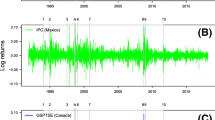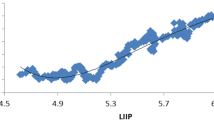Abstract
Understanding the characteristics of the dynamic relationship between the onshore Renminbi (CNY) and the offshore Renminbi (CNH) exchange rates considering the impact of some extreme events is very important and it has wide implications in several areas such as hedging. For better estimating the dynamic relationship between CNY and CNH, the Granger-causality test and Bry-Boschan Business Cycle Dating Algorithm were employed in this paper. Due to the intrinsic complexity of the lead-lag relationships between CNY and CNH, the empirical mode decomposition (EMD) algorithm is used to decompose those time series data into several intrinsic mode function (IMF) components and a residual sequence, from high to low frequency. Based on the frequencies, the IMFs and a residual sequence are combined into three components, identified as short-term composition caused by some market activities, medium-term composition caused by some extreme events and the long-term trend. The empirical results indicate that when it only matters the short-term market activities, CNH always leads CNY; while the medium-term impact caused by those extreme events may alternate the lead-lag relationships between CNY and CNH.
Similar content being viewed by others
References
Fratzscher M and Mehl A, China’s dominance hypothesis and the emergence of a tri-polar global currency system, The Economic Journal, 2014, 124(581): 1343–1370.
Henning C R, Choice and coercion in East Asian exchange rate regimes, Peterson Institute for International Economics, Working Paper, 2012.
Han A, Lai K K, Wang S, et al., An interval method for studying the relationship between the Australian dollar exchange rate and the gold price, Journal of Systems Science and Complexity, 2012, 25(1): 121–132.
Subramanian A and Kessler M, The Renminbi Bloc is Here: Asia down, rest of the World to go?, Journal of Globalization and Development, 2013, 4(1): 49–94.
Xie H and Wang S, A new approach to model financial markets, Journal of Systems Science and Complexity, 2013, 26(3): 432–440.
Ghodsi M and Yarmohammadi M, Exchange rate forecasting with optimum singular spectrum analysis, Journal of Systems Science and Complexity, 2014, 27(1): 47–55.
Shu C, He D, and Cheng X, One currency, two markets: The renminbi’s growing influence in Asia-Pacific, China Economic Review, 2015, 33: 163–178.
Gagnon J E and Troutman K, Internationalization of the renminbi: The role of trade settlement, Peterson Institute for International Economics, Working Paper, 2014.
Granger CWJ, Investigating causal relations by econometric models and cross-spectral methods, Econometrica, 1969, 37(3): 424–438.
De Jong F and Nijman T, High frequency analysis of lead-lag relationships between financial markets, Journal of Empirical Finance, 1997, 4(2–3): 259–277.
Owyong D, Wong W K, and Horowitz I, Cointegration and causality among the onshore and offshore markets for China’s currency, Journal of Asian Economics, 2015, 41: 20–38.
Gong C C, Ji S D, Su L L, et al., The lead-lag relationship between stock index and stock index futures: A thermal optimal path method, Physica A: Statistical Mechanics and Its Applications, 2016, 444: 63–72.
Ghosh A, Cointegration and error correction models: Intertemporal causality between index and futures prices, Journal of Futures Markets, 1993, 13(2): 193–198.
Shyy G, Vijayraghavan V, and Scott-Quinn B, A further investigation of the lead-lag relationship between the cash market and stock index futures market with the use of bid/ask quotes: The case of France, Journal of Futures Markets, 1996, 16(4): 405–420.
Judge A and Reancharoen T, An empirical examination of the lead-lag relationship between spot and futures markets: Evidence from Thailand, Pacific-Basin Finance Journal, 2014, 29: 335–358.
Cheung Y W and Rime D, The offshore renminbi exchange rate: Microstructure and links to the onshore market, Journal of International Money and Finance, 2014, 49: 170–189.
Bry G and Boschan C, Cyclical Analysis of Time Series: Selected Procedures and Computer Programs, National Bureau of Economic Research, New York, 1971.
Funke M, Shu C, Cheng X, et al., Assessing the CNH-CNY pricing differential: Role of fundamentals, contagion and policy, Journal of International Money and Finance, 2015, 59: 245–262.
Huang N E, Shen Z, Long S R, et al., The empirical mode decomposition and the Hilbert spectrum for nonlinear and non-stationary time series analysis, Proceedings of the Royal Society of London A: Mathematical, Physical and Engineering Sciences, The Royal Society, 1998, 454(1971): 903–995.
Huang N E, Wu M L C, Long S R, et al., A confidence limit for the empirical mode decomposition and Hilbert spectral analysis, Proceedings of the Royal Society of London A: Mathematical, Physical and Engineering Sciences, The Royal Society, 2003, 459(2037): 2317–2345.
Huang N E, Wu M L, Qu W, et al., Applications of Hilbert-Huang transform to non-stationary financial time series analysis, Applied Stochastic Models in Business and Industry, 2003, 19(3): 245–268.
Zhang X, Yu L, Wang S, et al., Estimating the impact of extreme events on crude oil price: An EMD-based event analysis method, Energy Economics, 2009, 31(5): 768–778.
Wang S Y, Yu L A, and Lai K K, Crude oil price forecasting with TEI@I methodology, Journal of Systems Science and Complexity, 2005, 18(2): 145–166.
Zhang X, Keung Lai K, and Wang S Y, Did speculative activities contribute to high crude oil prices during 1993 to 2008?. Journal of Systems Science and Complexity, 2009, 22(4): 636–646.
Author information
Authors and Affiliations
Corresponding author
Additional information
The research was partially supported by the National Natural Science Foundation of China under Grant Nos. 71390330, 71390331, 71390335. The first and third authors are very grateful to the National Nature Science Foundation of China for financial support to this study, the second author is supported by the Postdoctorate Programme of Centre University of Economics and Finance and the Postodctorate Programme of China Great Wall Asset Management Corporation.
This paper was recommended for publication by Editor YANG Cuihong.
Rights and permissions
About this article
Cite this article
Wei, Y., Wei, Q., Wang, S. et al. A Hybrid Approach for Studying the Lead-Lag Relationships Between China’s Onshore and Offshore Exchange Rates Considering the Impact of Extreme Events. J Syst Sci Complex 31, 734–749 (2018). https://doi.org/10.1007/s11424-017-6281-7
Received:
Revised:
Published:
Issue Date:
DOI: https://doi.org/10.1007/s11424-017-6281-7




